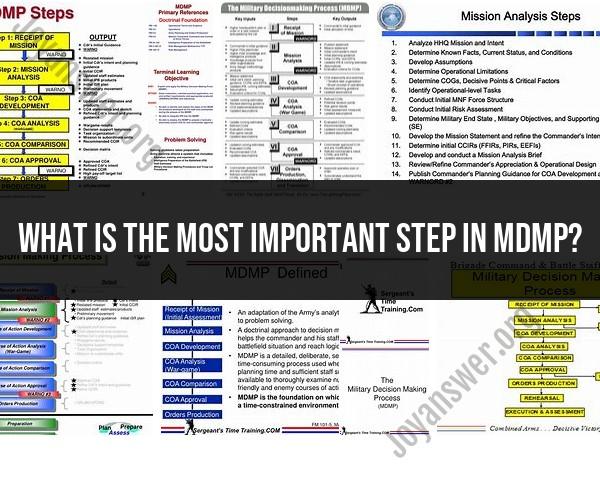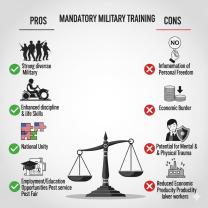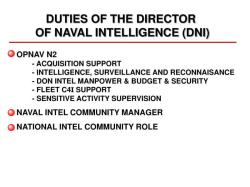What is the most important step in MDMP?
In the Military Decision-Making Process (MDMP), each step is critical to the overall process of planning and decision-making. However, "Mission Analysis" is often considered the most important step in MDMP. During Mission Analysis, a thorough understanding of the mission and the operational environment is developed, which forms the foundation for subsequent planning steps. Here's why Mission Analysis is regarded as crucial:
Situation Understanding: Mission Analysis involves a comprehensive assessment of the operational environment, including friendly, enemy, and other relevant forces, as well as the physical, human, and information environments. This understanding is essential for effective planning and decision-making.
Mission Analysis Variables: Mission Analysis identifies the mission variables, which are mission, enemy, terrain and weather, troops and support available, time available, and civil considerations (METT-TC). Analyzing these variables provides a holistic view of the situation, enabling commanders and staff to make informed decisions.
Mission Analysis Briefing: The results of Mission Analysis are typically presented in a formal briefing to the commander. This briefing helps the commander gain situational awareness and make critical decisions about the mission's purpose, the desired end state, and initial planning guidance.
Course of Action Development: Once the commander has a clear understanding of the situation and the mission's purpose, they can provide guidance to their staff for developing potential courses of action (COAs). The quality of COAs and their alignment with the commander's intent is heavily influenced by the accuracy of the Mission Analysis.
Focused Planning: A well-conducted Mission Analysis ensures that planning efforts are focused on addressing the specific challenges and opportunities presented by the operational environment. This, in turn, leads to more effective plans and more efficient resource allocation.
Risk Assessment: Mission Analysis helps identify risks associated with the mission, including vulnerabilities and threats. This information is critical for risk assessment and risk mitigation in subsequent planning steps.
While Mission Analysis is crucial, it's important to emphasize that MDMP is a systematic, iterative process where each step informs the next. The quality of decisions made during the later steps of MDMP depends on the accuracy and depth of analysis conducted during Mission Analysis. Therefore, it is often considered the linchpin of the entire MDMP process, setting the conditions for successful mission planning and execution.
The Most Important Step in MDMP (Military Decision-Making Process)
The Military Decision-Making Process (MDMP) is a seven-step process that commanders use to make decisions in complex and uncertain environments. The steps of the MDMP are:
- Receipt of mission: The commander receives the mission from higher headquarters.
- Mission analysis: The commander analyzes the mission to understand the commander's intent, the enemy, the terrain, and other factors.
- Course of action development: The commander develops courses of action (COAs) that will achieve the mission.
- Course of action analysis: The commander analyzes the COAs to determine their strengths and weaknesses.
- Course of action comparison: The commander compares the COAs to select the COA that best achieves the mission.
- Course of action approval: The commander approves the COA and issues orders to the troops.
- Orders production: The commander and staff produce orders that direct the troops to execute the COA.
The most important step in the MDMP is mission analysis. Mission analysis is the foundation of the MDMP. It is the process of understanding the mission and the environment in which the mission will be executed.
Mission analysis is important because it helps the commander to:
- Understand the commander's intent.
- Identify the enemy and other factors that will affect the mission.
- Develop COAs that will achieve the mission.
Without a thorough understanding of the mission and the environment, the commander will not be able to make sound decisions.
Understanding the Significance of Key Phases in MDMP
All of the steps in the MDMP are important, but some steps are more critical than others. The key phases in the MDMP are:
- Mission analysis: Mission analysis is the foundation of the MDMP. It is the process of understanding the mission and the environment in which the mission will be executed.
- Course of action development: Course of action development is the process of developing COAs that will achieve the mission.
- Course of action analysis: Course of action analysis is the process of analyzing the COAs to determine their strengths and weaknesses.
- Course of action comparison: Course of action comparison is the process of comparing the COAs to select the COA that best achieves the mission.
These key phases are critical because they are the steps in the MDMP where the commander makes decisions about how to achieve the mission.
Prioritizing and Executing Critical Actions in Military Decision-Making
When prioritizing and executing critical actions in military decision-making, commanders must consider the following:
- The mission: The mission is the commander's primary focus. All actions must be directed towards achieving the mission.
- The enemy: The commander must understand the enemy's capabilities and intentions. This will help the commander to develop COAs that are likely to succeed.
- The terrain: The commander must understand the terrain in which the mission will be executed. This will help the commander to develop COAs that are feasible and achievable.
- The available resources: The commander must consider the available resources when developing and executing COAs.
- The time available: The commander must consider the time available when developing and executing COAs.
By considering these factors, commanders can prioritize and execute critical actions in a way that is most likely to achieve the mission.
Conclusion
The MDMP is a complex and demanding process, but it is essential for commanders to make sound decisions in complex and uncertain environments. By understanding the MDMP and the key phases in the process, commanders can make better decisions and increase their chances of success.












